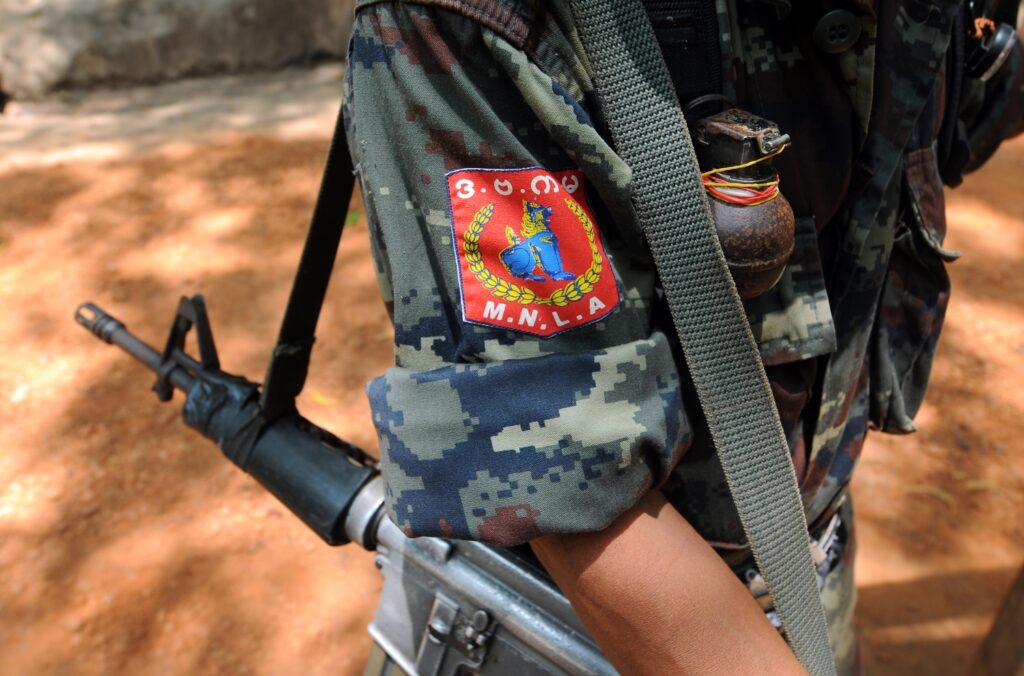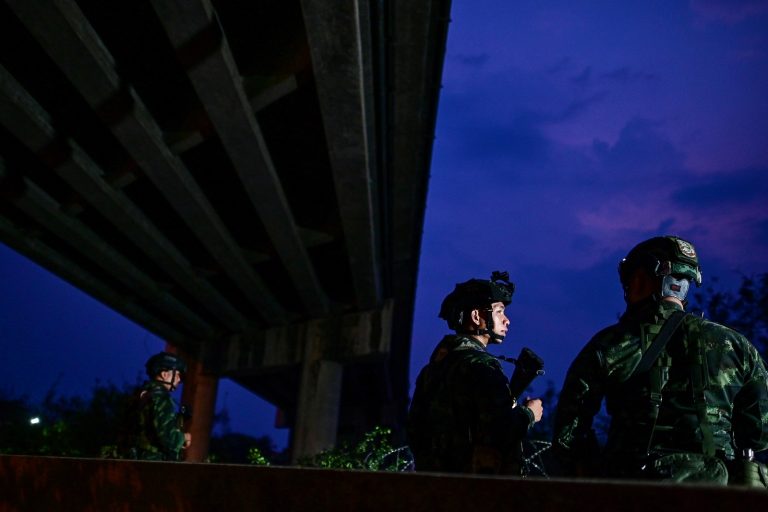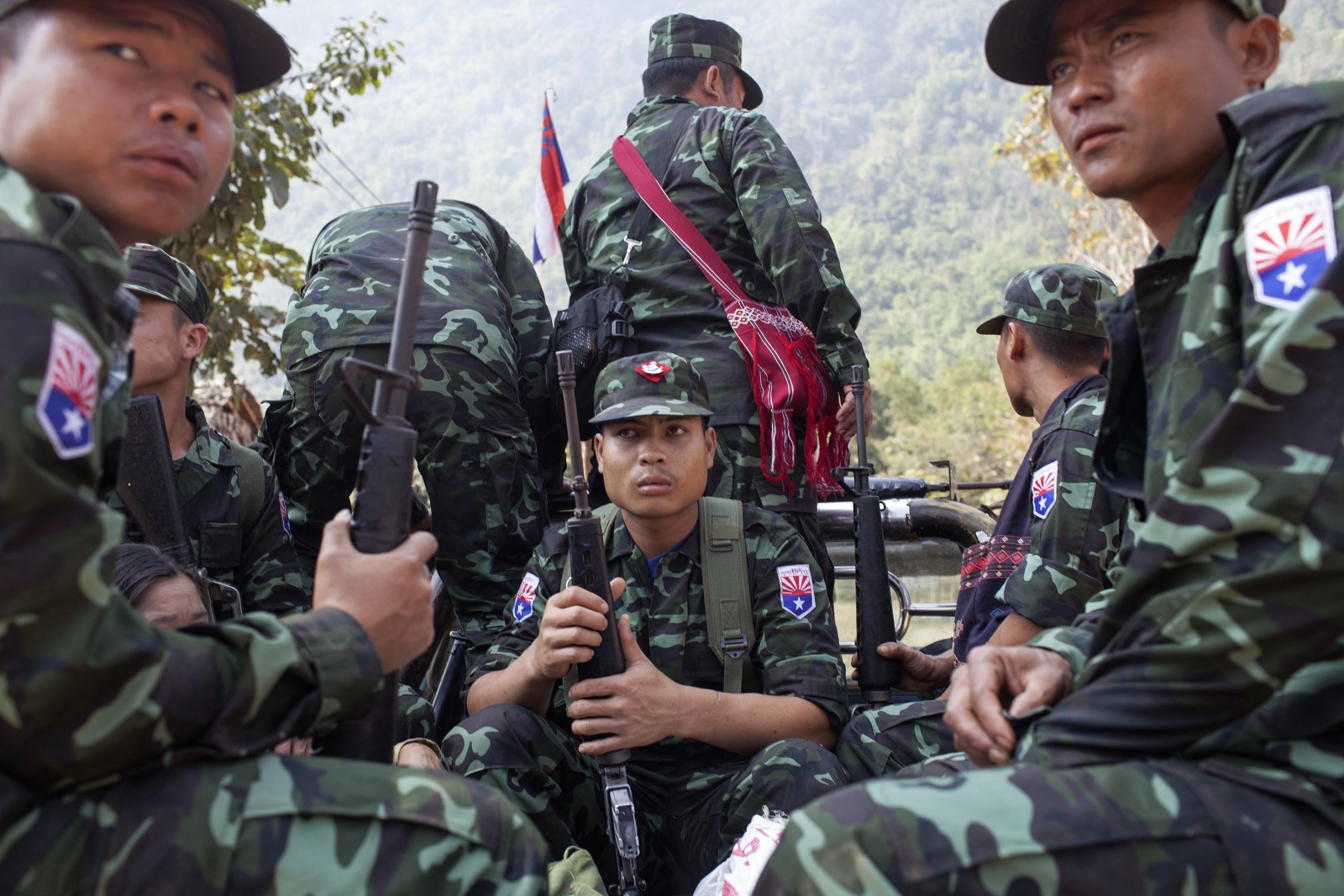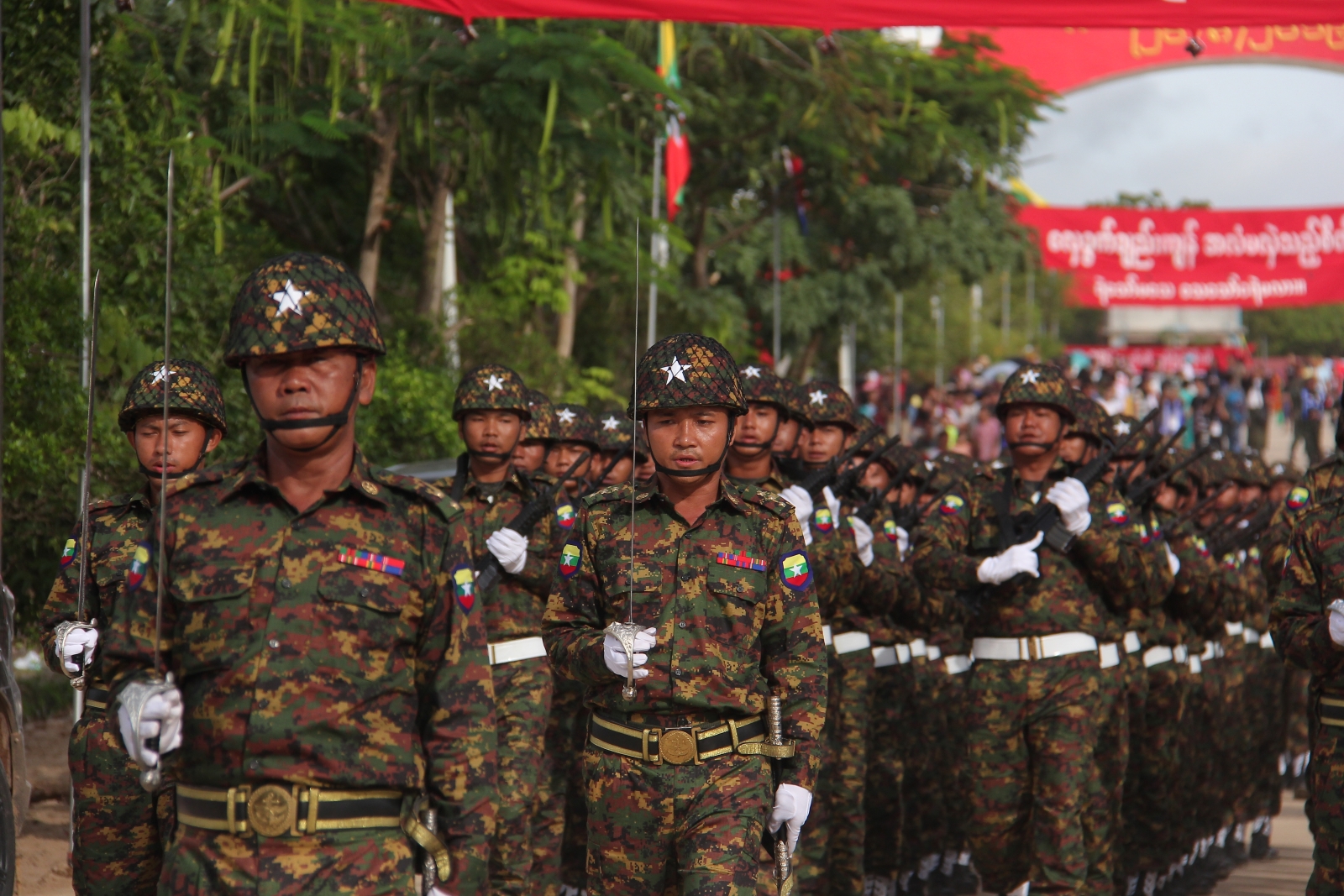Internal Mon divisions and tensions with other ethnic groups have hindered resistance efforts in Mon State. But as these efforts start to take shape, locals say they could either bring people together or pull them further apart.
By FRONTIER
The idea of a free Mon State was put to rest in 1995 when the New Mon State Party accepted a ceasefire offered by the ruling military junta, the State Law and Order Restoration Council.
The ceasefire was one of several negotiated with ethnic armed groups by the regime’s powerful intelligence chief, Lieutenant-General Khin Nyunt. But it was bitterly resented by some NMSP members, including Nai Han Thar, then a member of the central executive committee.
Han Thar refused to attend the negotiations, and two years later was demoted after signing the Mae Tha Raw Hta agreement without approval from the NMSP leadership. The agreement, signed by many influential ethnic armed groups, vowed to continue opposing the military.
Despite this rebellious streak, since 2020, Han Thar, also known as Nai Hongsar, has chaired the NMSP, which has largely sat on the sidelines of the armed uprising launched in response to the 2021 military coup. While other ethnic armed groups have clashed with the junta and trained a new generation of resistance fighters, the NMSP has held five rounds of peace talks with the State Administration Council, as today’s regime is formally known.
“I am still hoping that the New Mon State Party chairman has the bravery he showed in the past as a young commander. I know in my gut that he will never surrender to the military,” said Min Banyar, a fighter with the Ye People’s Defence Force in Mon’s Ye Township.
Like many PDFs, his group is loyal to the National Unity Government, a parallel administration appointed by lawmakers deposed in the coup. But in practice it operates under the command of the Karen National Liberation Army, the armed wing of the Karen National Union, an ethnic armed group allied with the NUG.
Frontier tried unsuccessfully several times to contact Han Thar, but he told the Independent Mon News Agency in June that “only dialogue will bring long-term peace”.
“However, we must caution our people that there may come a time when we have no choice but to fight,” he said, adding that civilians must be prepared.
Despite its irresolute stance on the conflict, the NMSP continues to enjoy broad support among Mon people, local sources say.
“The NMSP leaders are respected by the Mon because they were never involved in illegal or dirty businesses,” said Min Banyar.
A lawyer in Mawlamyine who requested anonymity said up till the 2021 coup, most Mon people followed the NMSP’s lead in pursuing peace. However, anti-junta uprisings in the state – led by groups unaffiliated with the NMSP – have forced hard choices on the veteran armed group and the wider Mon community.
“The fighting has spread to Mon State. It cannot be prevented,” the lawyer said. “The New Mon State Party is very worried that the military’s planes will begin to target large towns in the state. With the increasing power of the PDFs, such a situation is inevitable.”
A senior member of the NMSP, who asked not to be named, told Frontier that there is some difference of opinion among its nine top leaders and 27 central committee members.
Some members of the leadership want the NMSP to continue to meet its obligations under the Nationwide Ceasefire Agreement, which the group signed in 2018. Three of the other nine NCA signatories, including the powerful KNU, have suspended their participation in the negotiating process since the coup. Other, particularly lower-ranking, NSMP members want the group to take a similarly firm stand against the military.
“If we put the party membership on a scale, it would be weighted towards the resistance side,” he said, but admitted this is more symbolic support than a desire to join the uprising.
“Everyone agrees that we don’t want fighting in Mon State. Honestly, we’re not ready yet,” he said.
Bad blood with the NLD
One factor inhibiting Mon State’s role in the resistance is the legacy of the National League for Democracy in the state and the party’s association with the NUG.
The NMSP and the most prominent Mon political party, the Mon Unity Party, have had a fractured relationship with the NLD, which won a landslide reelection victory in 2020.
While the NLD won the most seats in Mon State, it was one of the few places where it lost ground compared to the 2015 election. The MUP, formed by a merger of two Mon parties to avoid splitting the vote, went on to win 11 seats in the state and national parliaments. Months before the election, the NMSP openly criticised the NLD for blocking federal reforms, such as a proposal to allow state parliaments to elect their own chief ministers.
Nai Nagar, a Mon political activist and spokesperson for the Mon State Revolutionary Force armed group, says the 2020 election highlighted tensions between the Mon and Bamar communities. After the vote, the NLD and MUP planned to meet to discuss cooperation in the next government, but the plan fell apart when the NLD insisted on meeting at its party headquarters while the MUP requested a neutral location.
“At that time, the comments of NLD supporters were really bad; there was racial incitement and hate speech,” Nai Nagar told Frontier.
Prior to the election, the NLD also sparked state-wide protests by naming a new bridge after General Aung San, father of NLD leader Daw Aung San Suu Kyi. While viewed as an independence icon by many Bamar for his central role in ending British colonial rule, some ethnic minorities instead see him as a symbol of Bamar colonialism.
While far more inclusive than previous administrations, the NUG was largely appointed by NLD lawmakers and many of its top ministers come from the party, making cooperation with the MUP or NMSP more delicate.
The senior NMSP member who asked to remain anonymous said the armed group has been approached by the NUG, but the parallel government failed to convince them.
“They just urged us to join the resistance, without outlining any specific federal policies that can help the Mon people,” he said.
Despite this, the NUG’s deputy defence minister is Nai Kao Rot, a former colonel from the NMSP’s armed wing.

On the other hand, some senior officials of the MUP even went as far as to join the junta after the coup. Senior party officials Nai Banyar Aung Moe and Nai Layi Tama were appointed to the union-level SAC and the Mon SAC respectively.
Nai Nagar said some Mon nationalist leaders had spread the message that the coup was merely a conflict between two Bamar groups – the Tatmadaw and the NLD – and that the Mon had nothing to do with it.
A member of the MUP’s Yangon Region central committee, Min Banyar Oo, defended the decision to cooperate with the junta to Frontier, saying it was done out of necessity, and not for the benefit of party members.
“Everyone needs a survival plan, and we are also seeking to survive,” he said. “In modern politics, we should not be the enemy of anyone, even if we hate them.”
Even so, more than 50 MUP members, including 21 members of its central executive committee, resigned in protest against the appointments.
“I think a lot of Mon people were disappointed by the MUP’s policy to work under the SAC,” said Min Banyar Htwe, a 52-year-old grocery shop owner in Mudon Township. “Some MUP supporters said they are trying to find a solution to the political deadlock, but I’m sure the majority of Mon people don’t like the MUP’s decision.”
Many of the members who resigned from the MUP went on to join resistance bodies affiliated with the NUG, like the Mon State Federal Council. The MSFC was originally established as the Mon State Interim Coordination Committee, and is represented by Kao Rot, the NUG deputy defence minister.
Since the coup, resistance groups in various states and regions have formed similar bodies, which work closely with the National Unity Consultative Council, an advisory body to the NUG.
But some supporters of the MSFC said that a rival, NLD-dominated body called the Mon State Consultative Council has been established.
Min Thet Ko, a 25-year-old student, said the MSCC is mostly made up of NLD members, including elected parliamentarians, from the north of the state – areas that he claims are majority Bamar rather than Mon.
“I haven’t seen them do anything effective in the last two years,” he said, calling MSFC more “promising” in comparison.
Kao Rot told Frontier the MSFC is trying to negotiate a merger with the MSCC, but so far have failed due to certain disagreements that he declined to disclose.
But much of this squabbling is lost on the general public. Banyar Htwe and another state resident Frontier interviewed said they didn’t know much about the MSCC-MSFC divide, and they hoped everyone could unite against the common enemy.
“I don’t know about the MSFC and MSCC. I’ve heard of many organisational rivalries like that in Mon State, but I hope that the NMSP can mobilise Mon people in the resistance,” Banyar Htwe said.
Kao Rot also said the MSFC is seeking to cooperate more with Karen fighters, who are closely affiliated with various PDFs and have increasingly moved into Mon State, posing another set of potential problems.
The Karen-PDF influx
Mon’s six southern townships that comprise Mawlamyine District are traditionally NMSP strongholds, while the four townships of Thaton District in the north include areas where the KNU has more influence.
When many young Mon men wanted to fight the junta after the coup, they were frustrated by the lack of support from the NMSP, so they moved north to receive guidance and training from the KNU.
The MSRF, for example, was founded in Thaton District in 2021 with training and weapons from the KNU and by last year, the group had become strong enough to move into southern Mon.
“Our goal is to be a dignified and honourable Mon army that never surrenders to the Myanmar military,” Nai Nagar said.
Likewise, the Ye Belu PDF and Ye PDF were able to gain footholds in Ye and Thanbyuzayat townships in southern Mon and Yebyu Township in neighbouring Tanintharyi Region to the south.
This has led to an increase in coordinated attacks on military targets, but also regime atrocities in retaliation.
Min Banyar of the Ye PDF said military reprisals have included the torturing and killing of civilians and burning of villages. But resistance fighters claim this had only increased their support among the general population.
Min Banyar said many who were previously unsympathetic “started supporting us because they began to realise who is protecting them”.
A 34-year-old betel farmer in Ye Township said fighting broke out near his village in June when PDFs attacked a police station, which the military responded to with an airstrike. While he had hoped Mon could avoid the violence engulfing the rest of the country, he didn’t blame resistance groups for bringing the fight to his doorstep.
“I hoped the NMSP would protect our village from the clashes, but they could not,” he said. Now, he hopes that the NMSP and Mon resistance groups “will unite to fight the military.”
Nai Nagar from the MSRF said his group had observed a similar trend. “One surprising fact is that once we started launching attacks, the Mon provided more and more support to resistance groups.”
But this support hasn’t yet reached the fervour seen in other conflict zones, and assistance from Mon living outside the state has been limited.
While many PDFs rely on public donations, including from the diaspora, newly-formed Mon resistance groups say they are struggling with a lack of funding, and admit the NMSP remains far more popular.
“There are more Mon resistance fighters than there are NMSP members in Mon State, but we cannot compete with its reputation and influence,” Nai Nagar explained.
One potential barrier is that the Mon PDFs work closely with the KNU, historically a rival of the NMSP. Over decades, the two groups have periodically clashed over territory, with tensions flaring again between 2016-2019.
“As a Mon national, I only want to see a Mon army in our land. I only trust armed groups representing our nationality,” said Banyar Htwe, the grocer in Mudon Township.
In June, a large coalition of KNLA and PDF fighters from KNU Brigade 6 territory moved into Ye Township.
Under the leadership of KNLA commander Colonel Saw Yan Naing, the coalition has allied with Mon PDFs. This has allowed them to patrol large sections of the strategic No. 8 Union Highway, which connects Mon with Bago Region to the north-west and Tanintharyi Region to the south.
“It’s a situation we never could have imagined in the past. The military is on the defensive and is being pressured from all sides by resistance groups,” said Kao Rot.
But he also acknowledged that the increased KNU and PDF presence and corresponding surge in fighting could anger some locals.
The Rehmonnya Institute for Civic Engagement, a Mon thinktank, even alleged in July that the recent influx could be a pretext for the KNU to create a Brigade 8 in NMSP territory.
“If the KNU decides to establish the 8th Brigade in an area predominantly inhabited by the Mon people, it could potentially lead to territorial tensions,” the report warns, adding the junta would “exploit the situation to its advantage”.
The thinktank attributed its claim to a “classified information source”, which Frontier could not independently verify, but regardless, it speaks to the anxieties Mon people have about the KNU.
Yan Naing denied this allegation, telling Frontier the KNU only hopes to open a new front in order to overstretch the regime.
Nai Nagar said there will need to be political negotiations in future between the Mon and Karen armed groups over territory, but the first priority is overthrowing the military.
“We believe we can negotiate politically with any other group, but the military is a barbaric organisation that can’t be negotiated with.”







